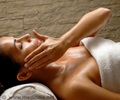Ohio State University researchers are using animal models to identify the mechanism behind how a massage helps speed up recovery amongst athletes following intense exercise and injury.
Animal models have been used by Ohio State University researchers to identify the mechanism behind how a massage helps speed up recovery amongst athletes following intense exercise and injury.
Athletes have always been using therapeutic massages for quick recovery from sports injuries.Scientists determined that immediate cyclic compression of muscles after intense exercise reduced swelling and muscle damage.
In the study using rabbits, the research team used one mechanical device to mimic movements associated with a specific kind of exercise, and a second device to follow the exercise with a simulated consistent massaging motion on the affected muscles.
"We tried to mimic Swedish massage because anecdotally, it's the most popular technique used by athletes," said Thomas Best, a professor of family medicine at Ohio State University and senior author of the study.
"A review of the research in this area shows that despite the existing anecdotal evidence - we know athletes use massage all the time - researchers don't know the mechanism of how massage improves recovery after exercise and injury," he added.
According to the American Massage Therapy Association, Swedish massage combines long strokes, kneading and friction techniques on muscles and various movements of joints.
Advertisement
The study showed that animals receiving simulated massage had improved muscle function, less swelling and fewer signs of inflammation than did muscles in the animals that received no massage treatment after exercise.
Advertisement
The massaged muscles recovered an estimated 60 percent of the strength after the four-day trial, compared to restoration of about 14 percent of strength in muscles that were exercised and then rested.
It had fewer damaged muscle fibres and virtually no sign of white blood cells, the presence of which would indicate that the body was working to repair muscle damage, when compared with the rested muscles.
The research is published in a recent issue of the journal Medicine and Science in Sports and Exercise.
Source-ANI
RAS/V














